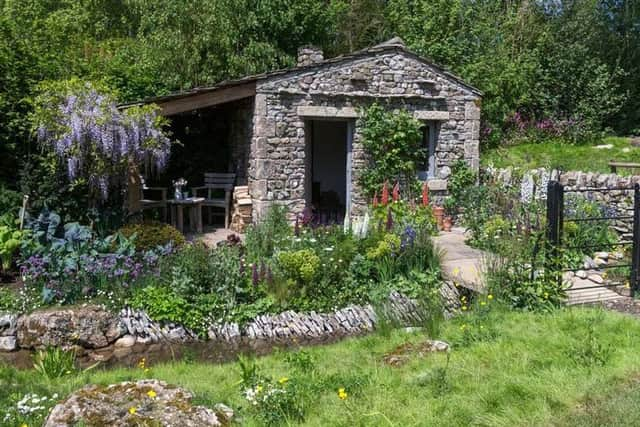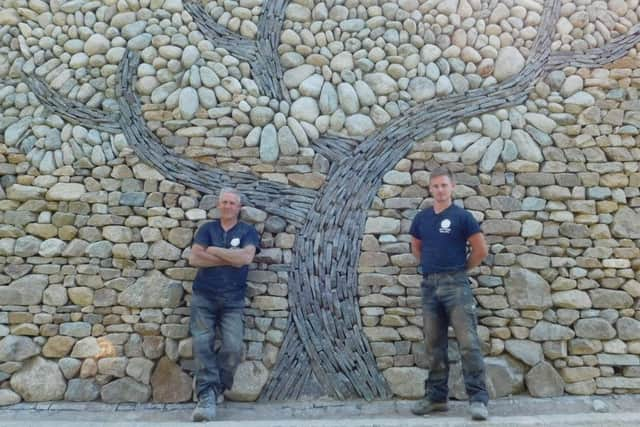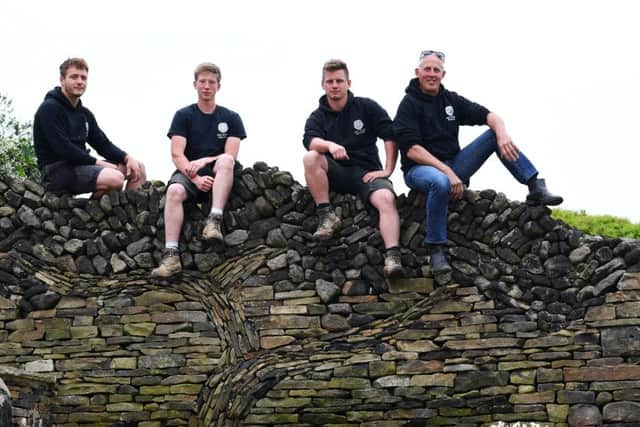Turning dry stone walling into an art form
It’s a near perfect English summer’s day. Glancing across the garden, I can see bees gathering nectar from rows of flowers and shrubs that sway rhythmically in the gentle breeze. It is the kind of day that makes you wish you worked outside, something that Richard Clegg has been doing for much of his working life. He’s been running his dry stone walling business for the past 21 years, during which time he’s enjoyed growing recognition and success.
Today, he’s working in the garden of one of his clients just outside Burley in Wharfedale. “At the moment I’m doing a fire pit,” he says, pointing to a piece of sculpted stone. “I deliberately designed this as a crescent seat and it’s light stone almost chalk-like, but it’s not chalk, it’s actually sandstone and it lives very nicely with the honey colours we have with the other kinds of stone, so it will stand out. You have the fire pit representing the sun and then you’ve got the crescent seat representing the moon.”
Advertisement
Hide AdAdvertisement
Hide AdIf Clegg sounds almost like an artist talking about a sculpture it’s because in many respects he is.


It’s been a good year so far for him and his team having worked on Mark Gregory’s award-winning Welcome to Yorkshire scene, inspired by the Yorkshire Dales, which won a gold medal in the Show Garden category and People’s Choice at the Chelsea Flower Show in May.
Clegg spent hours researching his part of the project. “I was on my Triumph Bonneville and off to Wensleydale. I rode around the gorgeous countryside soaking in the influences such as the dry stone walls, the type of stonework used in the houses and the flowing becks with their cascading waterfalls,” he says.
“Then came the adventure of bagging and loading the stone for Chelsea. We went out to the moors while the snow was still on the ground. The only way to achieve an authentic garden is to use authentic materials and the best way to get a feel for those materials is to handle them in their environment. Then came the fine details such as the rusty fence wire, an abandoned swallows nest and a soon to be famous cow pat!”
Advertisement
Hide AdAdvertisement
Hide AdClegg himself has become a bit of a Chelsea regular – this year’s garden was the fifth design he’s worked on at the show for Welcome to Yorkshire.


But if he’s established himself as an eminent dry stone wall expert, it’s taken a lot of blood, sweat and tears to get there.
He was an art student at (what was) Huddersfield Polytechnic when he dropped out after becoming disillusioned by what he felt was the growing fashion for “conceptual art”.
He found a job on a farm, where he spent time walling, and then turned his hand to silkscreen printing before setting up his own ceramics business. He finally formed his own dry stone walling business in 1997.
Advertisement
Hide AdAdvertisement
Hide Ad“I spent about six years working on the moors doing agricultural work. I was out there in the elements in all kinds of weather,” he says.


“After you’ve done miles and miles of walls on the moors you look around and realise you’ve done nothing compared to the landscape, and I think I reached the point where I realised it wasn’t going to engage me any more than it had.”
He branched out into doing more garden work and in 2003 did his first Chelsea Flower Show for a garden sponsored by Yorkshire Forward.
It proved a springboard to doing work that was more creative, a word that some people might not necessarily associate with walling which has something of a staid, old-fashioned image.
Advertisement
Hide AdAdvertisement
Hide AdBut Clegg, who runs RLC Dry-Stone Walling Ltd from Holmfirth, insists it’s a small but vibrant industry. “A lot of people assume it’s a dying art but it’s not and it can be artistically engaging. If I’m in a garden I’m doing all kinds of different features, things like waterfalls, follies, contouring and terracing and tree features.”
He’s proud, too, that it’s a family affair – his eldest son, Lewyn, works full time alongside him and his youngest son, Eryn, chips in, while his wife, Helen, is what he calls “the organisational brain” of the team.
Their work isn’t just confined to this county, or even this country. “It’s a growing market, I’m sure of it,” he says. “We did a job in the Tatra Mountains in Slovakia for a guy who basically owned a mountain. He already had a private lake and the wall we built was basically the cladding against the concrete wall holding back his lake.”
In Britain, dry stone walls have long been a feature of our countryside. There are estimated to be over 5,000 miles in the Yorkshire Dales alone, some dating back over 600 years to when they were built to repel wolves.
Advertisement
Hide AdAdvertisement
Hide AdClegg believes their appeal still endures. “I think it looks far better than rendered concrete, or fencing and decking. There’s an atmosphere that stone conveys and it’s all about stone and heart. There’s a feeling about stone that encourages a sense of wellbeing and dry stone walls also offer a habit for nature’s little creatures.”
And to him the allure is simple. “A lot of people might think it’s boring but it’s not, it can be a daily form of expression. It’s almost zen-like and sometimes I feel like I’ve discovered a secret, I really do, because I get paid for doing something I love and it keeps me healthy. What could be better than that?”